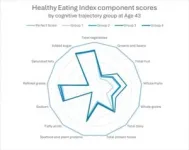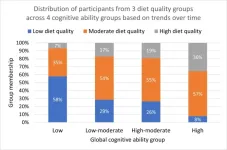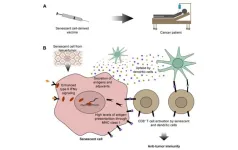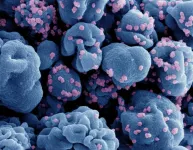(Press-News.org) CHAMPAIGN, Ill. — A new method of precisely targeting troublesome cells for death using light could unlock new understanding of and treatments for cancer and inflammatory diseases, University of Illinois Urbana-Champaign researchers report.
Inflammatory cell death, knows as necroptosis, is an important regulatory tool in the body’s arsenal against disease. However, in some diseases, the process can go haywire; for example, cancer cells are able to suppress inflammatory signals and thus escape death.
“Usually treatments for cancer use pharmacological induction to kill the cells, but those chemicals tend to diffuse throughout the tissues and it’s hard to contain to a precise location. You get a lot of unwanted effects,” said study leader Kai Zhang, a professor of biochemistry at the U. of I. “We can make the cells responsive to light, and we can focus the light beam to be smaller than one cell. That is how we can use light to very precisely target a cell and turn on its death pathway.”
The researchers use a method called optogenetics to make the cells respond to light. They borrowed a light-activated gene from plants and inserted it into intestinal cell cultures, attaching it to the gene for RIPK3, a protein that regulates necroptosis.
“When activated, RIPK3 undergoes oligomerization — it forms clusters of protein complexes. Our light-sensitive proteins cluster together when exposed to blue light. So by triggering the light-sensitive proteins to come together, the RIPK3 comes together and oligomerizes, and that’s how we mimic the activation pathway,” said graduate student Teak-Jung Oh, the first author of the paper published in the Journal of Molecular Biology.
However, killing the cell itself is not the only goal. Inducing the inflammatory cell death pathway, rather than outright killing the cell mechanically or chemically, triggers the immune system to respond. The ruptured cells release chemicals called cytokines that irritate nearby cells and attract T cells, white blood cells that play an important role in how the immune system identifies and attacks threats, Zhang said.
“Certain cancer cell types create a local immunosuppressive environment, where T cells are either not recruited or, if they do come, they do not recognize it as a threat and do not infiltrate the cancerous area. But by opening up some cancer cells through necroptosis, we hope to modulate this immune suppressive environment and help train the T cells to recognize and attack the cancer,” said Zhang, who is a member of the Cancer Center at Illinois.
Since the optogenetic system requires light delivery directly to tissues, human clinical applications in tissues deeper than skin are currently limited. However, the Illinois group plans to implement their system in mice next to further study necroptosis and immune response in cancer and other inflammatory diseases. They also will further investigate the in vitro platform’s potential for training T cells for immune therapies.
“Understanding the cell signaling pathway for necroptosis is especially important because it has been known to be involved with diseases like neurodegenerative disease and inflammatory bowel disease. Knowing how necroptosis affects progression in these diseases is important. And if you don’t know the molecular mechanisms, you don’t really know what to target to slow the progression,” Oh said.
The National Institute of General Medical Sciences and National Institute of Mental Health of the National Institutes of Health, the National Science Foundation and the Cancer Center at Illinois supported this work. Zhang also is affiliated with the Beckman Institute for Advanced Science and Technology at Illinois.
Editor’s note: To reach Kai Zhang, email kaizkaiz@illinois.edu.
The paper, “Spatiotemporal control of inflammatory lytic cell death through optogenetic induction of RIPK3 oligomerization,” is available online. DOI: 10.1016/j.jmb.2024.168628
The National Institutes of Health supported this work through grants R01GM132438 and R01MH124827.
END
Light targets cells for death and triggers immune response with laser precision
2024-07-01
ELSE PRESS RELEASES FROM THIS DATE:
Dr. Harish Manyam revolutionizes cardiac care with innovative device
2024-07-01
Harish Manyam, MD, is on a mission to improve the lives of people with heart problems. His recent accomplishment of implanting Tennessee’s first atrial leadless pacemaker is a step toward that, marking a significant advancement in cardiac care and promising safer and more effective treatment for patients.
The leadless pacemaker, in combination with a novel subcutaneous defibrillator, forms a groundbreaking system that addresses potentially dangerous problems associated with traditional pacemakers and defibrillators.
“This is a great leap forward for the field,” said Dr. Manyam, interim chair of the Department of Medicine at the ...
Want to stay mentally sharp longer? Eat a healthy diet now
2024-07-01
Chicago (July 1, 2024) — Eating a high-quality diet in youth and middle age could help keep your brain functioning well in your senior years, according to new preliminary findings from a study that used data collected from over 3,000 people followed for nearly seven decades.
The research adds to a growing body of evidence that a healthy diet could help ward off Alzheimer’s disease and age-related cognitive decline. Whereas most previous research on the topic has focused on eating habits of people in their 60s and 70s, the new study is the first to track diet and ...
Medication choice may affect weight gain when initiating antidepressant treatment
2024-07-01
Embargoed for release until 5:00 p.m. ET on Monday 1 July 2024
Annals of Internal Medicine Tip Sheet
@Annalsofim
Below please find summaries of new articles that will be published in the next issue of Annals of Internal Medicine. The summaries are not intended to substitute for the full articles as a source of information. This information is under strict embargo and by taking it into possession, media representatives are committing to the terms of the embargo not only on their own behalf, but also on behalf of the organization ...
Weight change across common antidepressant medications
2024-07-01
Boston, MA – New evidence comparing weight gain under eight different first-line antidepressants finds that bupropion users are 15-20% less likely to gain a clinically significant amount of weight than users of sertraline, the most common medication.
The findings are published July 2 in Annals of Internal Medicine.
Antidepressants are among the most commonly prescribed medications in the U.S., with 14% of U.S. adults reporting using an antidepressant. Weight gain is a common side effect, which could affect patients’ long-term metabolic health and cause some to stop taking their prescribed treatment, leading ...
Dampening the "seeds" of hurricanes
2024-07-01
Dampening the "seeds" of hurricanes
Increased atmospheric moisture produced weaker hurricane formation
Increased atmospheric moisture may alter critical weather patterns over Africa, making it more difficult for the predecessors of many Atlantic hurricanes to form, according to a new study published this month.
The research team, led by scientists from the U.S. National Science Foundation National Center for Atmospheric Research (NSF NCAR), used an innovative model that allows for higher-resolution simulations of hurricane formation than ever before. This allowed researchers to study the effects of increased regional moisture over Africa, which is the birthplace of ...
Senescent cell-derived vaccines: A new concept towards an immune response against cancer and aging?
2024-07-01
“[...] cancer immunotherapy based on tumor-associated senescent cells and other types of senescent cells may achieve exciting outcomes beyond cancer therapy.”
BUFFALO, NY- July 1, 2024 – A new review paper was published on the cover of Aging (listed by MEDLINE/PubMed as "Aging (Albany NY)" and "Aging-US" by Web of Science) Volume 16, Issue 12, entitled, “Senescent cell-derived vaccines: a new concept towards an immune response against cancer and aging?”
Two recent seminal works have untangled the intricate role of tumor-associated senescent cells in cancer progression, or regression, by guiding our immune system against cancer ...
Danforth Plant Science Center President & CEO announces leadership transition plan
2024-07-01
ST. LOUIS, MO., July 1, 2024 – Today, Donald Danforth Plant Science Center President and CEO Jim Carrington, PhD, announced he will step down on July 1, 2025.
“I’ve been so fortunate to have had this opportunity over the past 13 years,” said Dr. Carrington. “We’ve been able to do so much because of our exceptional people, our partners and our supporters. But it’s time to plan for a transition, and I know the Center will benefit greatly from the renewal of perspective, ideas ...
NIH-sponsored trial of nasal COVID-19 vaccine opens
2024-07-01
A Phase 1 trial testing the safety of an experimental nasal vaccine that may provide enhanced breadth of protection against emerging variants of SARS-CoV-2, the virus that causes COVID-19, is now enrolling healthy adults at three sites in the United States. The National Institutes of Health (NIH) is sponsoring the first-in-human trial of the investigational vaccine, which was designed and tested in pre-clinical studies by scientists from NIH’s National Institute of Allergy and Infectious Diseases (NIAID) Laboratory of Infectious Diseases.
“The rapid development ...
Commercial stock photos of farmworkers found lacking
2024-07-01
A new North Carolina State University study examining the availability and content of commercial stock farmworker photos – images often used in health- and safety-education materials for farmworkers – shows a dearth of useful depictions of the people who work on farms and the tasks they perform. The study’s recommendations could lead to more relevant education materials that gain more attention and engagement from farmworkers
“I was really interested in how farmworkers were represented in stock-photo libraries,” said Catherine LePrevost, agromedicine extension specialist and associate extension professor in NC State’s Department ...
Genetic patterns of world’s farmed, domesticated foxes revealed via historical deep-dive
2024-07-01
URBANA, Ill. — Domesticated animals play a prominent role in our society, with two-thirds of American families enjoying the companionship of pets and many others relying on animal products for their nutritional needs. But the process of domestication remains a bit of a mystery. Convincing wild animals they are safe enough to coexist and mate in enclosures and in close proximity to humans and other animals is no small feat. What does it take behaviorally and genetically for that to happen?
For the most part, the animals we’ve domesticated have been docile for so long that ...







